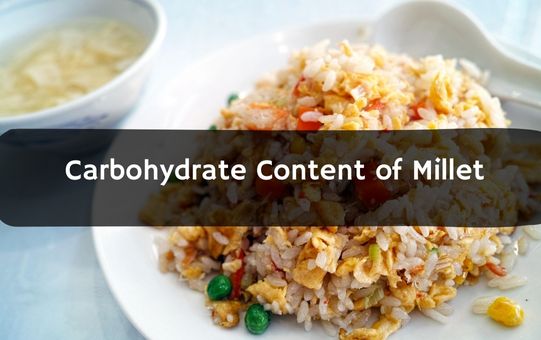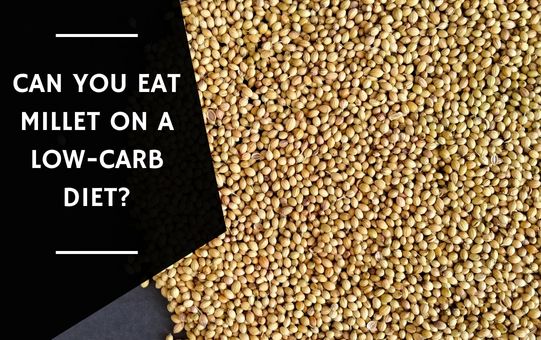Millet is frequently favored as a healthier alternative to wheat and other grains. But Can you eat millet on a low-carb diet?
Yes, you can eat millet while following a low-carb diet, but you should also consume other low-carb foods. One grain that may be healthy for those following a low-carb diet is millet, which is high in nutrients and has a moderate to low glycemic index.
Always seek the advice of a medical professional or registered dietitian before making significant dietary changes.
In addition to other dietary considerations for including millet in your diet, this article examines the carbohydrate content, glycemic index, and role of millet in a low-carb diet.
Contents
Why eat millet on a low-carb diet matter?
Eating millet on a low-carb diet can be beneficial for a few reasons. First, millet is a nutrient-rich grain that is high in B vitamins, magnesium, and iron, as well as is a good source of plant-based protein.
Additionally, millet is naturally gluten-free, making it a suitable choice for those following a gluten-free diet.
Second, millet has a moderate to low glycemic index, which means that it is absorbed somewhat slowly by the body and does not cause a rapid spike in blood sugar.
This can be beneficial for those following a low-carb diet, as it helps to regulate blood sugar levels and may reduce the risk of spikes in insulin and other hormones.
Finally, including millet in a low-carb diet can add variety and flavor to meals, making it easier to stick to the diet long-term.
Read Also: Does Millet Cause Heat?
The Carbohydrate Content of Millet
So, how many carbs are in millet? According to the USDA, a 1/2 cup (99 grams) serving of cooked millet contains approximately 21 grams of carbohydrates. This may seem like a lot for a low-carb diet, but it’s important to note that millet also contains about 3 grams of dietary fiber per serving, which can help to offset the impact of the carbs on blood sugar levels.
In comparison, a 1/2 cup serving of cooked brown rice contains about 15 grams of carbs, while a 1/2 cup serving of cooked quinoa contains about 21 grams of carbs. This means that millet is not necessarily higher in carbs than other grains, and can potentially be included in a low-carb diet in moderation.

The Glycemic Index of Millet
The glycemic index (GI) is a measure of how quickly a particular food raises blood sugar levels. Foods with a high GI are absorbed more quickly by the body and cause a rapid increase in blood sugar, while foods with a low GI are absorbed more slowly and cause a slower, more sustained increase in blood sugar.
Millet has a moderate to low glycemic index, with a value of around 72. This means that it is absorbed somewhat slowly by the body and does not cause a rapid spike in blood sugar. In comparison, white bread has a glycemic index of 70, while watermelon has a glycemic index of 72.
The Role of Millet in a Low-Carb Diet
So, can you eat millet on a low-carb diet? The answer is yes, but it’s important to be mindful of portion sizes and to balance millet with other low-carb foods.
As mentioned earlier, a 1/2 cup serving of cooked millet contains 21 grams of carbs, which is about one-quarter of the daily carb limit for a person following a very low-carb diet (20 grams of carbs per day).
For this reason, it’s important to consider the other sources of carbs in your diet when including millet.
For example, if you are following a low-carb diet that allows for 100 grams of carbs per day, you could potentially include a serving of millet (21 grams of carbs) along with other low-carb foods like leafy greens, nuts, and protein sources.
It’s also worth noting that millet may be more suitable for those following a moderate or liberal low-carb diet (allowing for more than 100 grams of carbs per day), rather than a very low-carb diet.
Other Considerations for Adding Millet to a Low-Carb Diet
In addition to the carbohydrate content of millet, there are a few other considerations to keep in mind when adding it to a low-carb diet.
First, it’s important to consider the other ingredients that are added to millet dishes. For example, adding high-carb ingredients like sugar or dried fruit to a millet dish can significantly increase the carbohydrate content.
It’s important to choose low-carb ingredients when preparing millet dishes to ensure that they fit into your low-carb diet.
Second, it’s important to be mindful of the portion size of millet when adding it to a low-carb diet. As mentioned earlier, a 1/2 cup serving of cooked millet contains 21 grams of carbs, which can add up quickly if multiple servings are consumed.
To ensure that millet fits into your low-carb diet, it’s important to be mindful of portion sizes and to balance it with other low-carb foods.
Finally, it’s important to remember that every person is different and may have different nutrient needs and tolerances.
It’s always a good idea to speak with a healthcare provider or registered dietitian before making any significant changes to your diet, including the addition of millet or any other new food.
Read Also: Can You Eat Millet Cold?
Conclusion
Millet can potentially be included in a low-carb diet, but it’s important to be mindful of portion sizes and to balance it with other low-carb foods.
Millet is a nutrient-rich grain that is naturally gluten-free and has a moderate to the low glycemic index, making it a potentially healthy choice for those following a low-carb diet.
However, it’s always a good idea to speak with a healthcare provider or registered dietitian before making any significant changes to your diet.
FAQs | Eat Millet on a Low-Carb Diet
here are five potential FAQs related to the topic of consuming millet on a low-carbohydrate diet:
Is Millet A Low-Carb Grain?
Millet is not a low-carbohydrate grain. One cup of cooked millet contains approximately 37 grams of carbohydrates, which is relatively high compared to some other grains.
However, it is important to note that the carbohydrate content of millet can vary depending on the specific variety and how it is prepared.
Can I Include Millet In My Low-Carb Meal Plan?
If you are following a strict low-carbohydrate diet, it may be challenging to include millet in your meal plan due to its high carbohydrate content.
However, if you are following a more moderate low-carb diet or are simply trying to reduce your overall carbohydrate intake, you may be able to include small amounts of millet in your meals.
How Does Millet Compare To Other Grains In Terms Of Carbohydrate Content?
Is Millet A Low-Carb Grain?
Millet is not a low-carbohydrate grain. One cup of cooked millet contains approximately 37 grams of carbohydrates, which is relatively high compared to some other grains.
However, it is important to note that the carbohydrate content of millet can vary depending on the specific variety and how it is prepared.
Can I Include Millet In My Low-Carb Meal Plan?
If you are following a strict low-carbohydrate diet, it may be challenging to include millet in your meal plan due to its high carbohydrate content.
However, if you are following a more moderate low-carb diet or are simply trying to reduce your overall carbohydrate intake, you may be able to include small amounts of millet in your meals.
Are There Any Potential Benefits To Eating Millet On A Low-Carb Diet?
Millet is a good source of nutrients, including B vitamins, magnesium, and phosphorus. It is also a good source of plant-based protein and can be a useful ingredient in a low-carb meal plan for those following a vegetarian or vegan diet.
However, it is important to keep in mind that the carbohydrate content of millet may not be suitable for everyone following a low-carb diet.
Are There Any Low-Carb Recipes That Incorporate Millet As An Ingredient?
There are many low-carb recipes that incorporate millet as an ingredient, including savory dishes like millet and vegetable stir fry, and sweet dishes like millet and fruit breakfast bowls.
You can also use cooked millet as a base for grain bowls or as a replacement for rice in dishes like stuffed peppers or grain bowls.

